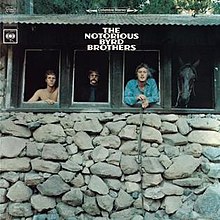
Back The Notorious Byrd Brothers Czech The Notorious Byrd Brothers German The Notorious Byrd Brothers Spanish The Notorious Byrd Brothers Finnish The Notorious Byrd Brothers French The Notorious Byrd Brothers Galician The Notorious Byrd Brothers Hungarian The Notorious Byrd Brothers Italian 名うてのバード兄弟 Japanese The Notorious Byrd Brothers Korean
| The Notorious Byrd Brothers | ||||
|---|---|---|---|---|
 | ||||
| Studio album by | ||||
| Released | January 15, 1968[nb 1] | |||
| Recorded | June 21 – December 6, 1967 | |||
| Studio | Columbia, Hollywood | |||
| Genre | ||||
| Length | 28:28 | |||
| Label | Columbia | |||
| Producer | Gary Usher | |||
| The Byrds chronology | ||||
| ||||
| Singles from The Notorious Byrd Brothers | ||||
| ||||
The Notorious Byrd Brothers is the fifth album by the American rock band the Byrds, and was released in January 1968, on Columbia Records.[1][2] The album represents the pinnacle of the Byrds' late-'60s musical experimentation, with the band blending together elements of psychedelia, folk rock, country, electronic music, baroque pop, and jazz.[3][4][5] With producer Gary Usher, they made extensive use of a number of studio effects and production techniques, including phasing, flanging, and spatial panning.[6][7][8] The Byrds also introduced the sound of the pedal steel guitar and the Moog modular synthesizer into their music, making it one of the first LP releases on which the Moog appears.[7][9]
Recording sessions for The Notorious Byrd Brothers took place throughout the latter half of 1967 and were fraught with tension, resulting in the loss of two members of the band;[9] rhythm guitarist David Crosby was fired in October 1967 and drummer Michael Clarke left the sessions midway through recording, returning briefly before finally being dismissed after completion of the album.[10][11] Additionally, original band member Gene Clark, who had left the group in early 1966, rejoined for three weeks during the making of the album, before leaving again.[12] Author Ric Menck has commented that in spite of these changes in personnel and the conflict surrounding its creation, The Notorious Byrd Brothers is the band's most cohesive and ethereal-sounding album statement.[13]
The Notorious Byrd Brothers reached number 47 on the Billboard Top LPs chart and number 12 on the UK Album Chart.[14][15] A cover of the Gerry Goffin and Carole King song "Goin' Back" was released in October 1967 as the lead single from the album to mild chart success.[7] Although The Notorious Byrd Brothers was critically praised at the time of its release, it was only moderately successful commercially, particularly in the United States.[16] The album later came to be widely regarded as one of the Byrds' best album releases, as well as their most experimental and progressive.[5][6][13] Byrds expert Tim Connors has described the album's title as evoking a gang of outlaws from the American Old West.[4]
Cite error: There are <ref group=nb> tags on this page, but the references will not show without a {{reflist|group=nb}} template (see the help page).
- ^ Rogan, Johnny (1998). The Byrds: Timeless Flight Revisited (2nd ed.). Rogan House. pp. 544–546. ISBN 0-9529540-1-X.
- ^ "The Notorious Byrd Brothers review". AllMusic. Retrieved January 10, 2010.
- ^ Rogan, Johnny. (1998). The Byrds: Timeless Flight Revisited (2nd ed.). Rogan House. pp. 240–247. ISBN 0-9529540-1-X.
- ^ a b "The Notorious Byrd Brothers". ByrdWatcher: A Field Guide to the Byrds of Los Angeles. Archived from the original on May 22, 2010. Retrieved August 22, 2009.
- ^ a b Fricke, David. (1997). The Notorious Byrd Brothers (1997 CD liner notes/rear cover).
- ^ a b Bob Olsen. "The Byrds – The Notorious Byrd Brothers review". Music Tap. Retrieved February 21, 2015.
- ^ a b c Hjort, Christopher. (2008). So You Want To Be A Rock 'n' Roll Star: The Byrds Day-By-Day (1965–1973). Jawbone Press. pp. 148–153. ISBN 978-1-906002-15-2.
- ^ Menck, Ric. (2007). The Notorious Byrd Brothers (33⅓ series). Continuum Books. pp. 113–116. ISBN 978-0-8264-1717-6.
- ^ a b Hjort, Christopher. (2008). So You Want To Be A Rock 'n' Roll Star: The Byrds Day-By-Day (1965–1973). Jawbone Press. p. 117. ISBN 978-1-906002-15-2.
- ^ Rogan, Johnny. (1998). The Byrds: Timeless Flight Revisited (2nd ed.). Rogan House. pp. 228–234. ISBN 0-9529540-1-X.
- ^ Rogan, Johnny. (1998). The Byrds: Timeless Flight Revisited (2nd ed.). Rogan House. pp. 237–238. ISBN 0-9529540-1-X.
- ^ Einarson, John. (2005). Mr. Tambourine Man: The Life and Legacy of the Byrds' Gene Clark. Backbeat Books. pp. 126–127. ISBN 0-87930-793-5.
- ^ a b Menck, Ric. (2007). The Notorious Byrd Brothers (33⅓ series). Continuum Books. pp. 79–83. ISBN 978-0-8264-1717-6.
- ^ Whitburn, Joel. (2002). Top Pop Albums 1955–2001. Hal Leonard Corp. p. 121. ISBN 0-634-03948-2.
- ^ Brown, Tony. (2000). The Complete Book of the British Charts. Omnibus Press. p. 130. ISBN 0-7119-7670-8.
- ^ Hjort, Christopher. (2008). So You Want To Be A Rock 'n' Roll Star: The Byrds Day-By-Day (1965–1973). Jawbone Press. pp. 157–158. ISBN 978-1-906002-15-2.
© MMXXIII Rich X Search. We shall prevail. All rights reserved. Rich X Search